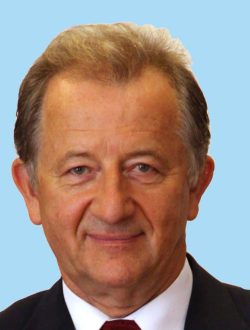Biography
Jozef W. Modelski (SM’90, FM’01) was born in Poland in 1949. He received his M.Sc., Ph.D. and D.Sc. (habilitation) degrees in electronics from the Warsaw University of Technology in 1973, 1978 and 1987, respectively. In 1994 he obtained the state title of Professor. Since 1973 he has been with the Institute of Radioelectronics, Warsaw University of Technology (WUT), holding in sequence all academic positions from teaching/research assistant to tenured professor (1991). In 1976/77 he was in the US as a Fluorite grantee with the University of Texas in Austin, Cornell University and COMSAT Laboratories. In 1985 he visited Germany as a DAAD grantee and in 1986 he joined for 2 years the Braunschweig Technical University (Germany) as a senior scientist. Since 1996 he has held the position of Director of the Institute of Radioelectronics of the Warsaw University of Technology. His research interests include the area of: microwave modulators and shifters with semiconductor and ferrite elements, dielectric resonators and their applications, integrating waveguide technology, methods and equipment of material properties measurements and recently ferroelectric and smart antennas for communication systems. J. Modelski is the author and coauthor of over 200 technical papers, 4 mongraphs and obtained 9 patents. He acts as consultant to industry and Polish government agencies. In the 90’s, his main areas of IEEE activities were related to chairing in 1990–1995 the AES/AP/MTT Joint Chapter in Poland as well as membership promotion in countries of the former Soviet Union. In 1996 he was appointed MTT Region 8 Coordinator and in 1997-98 was Chairman of the MTT Transnational Committee. He co-organized a series of Divisions I & IV Region 8 Chapter Chairs meetings (1996-2000). Since the very beginning (1993) he has been key member of the MTT/ED Joint Ad Hoc Committee for Membership Promotion and Chapter Formation in Eastern Europe/Former Soviet Union. This initiative resulted in the establishing of over 20 new chapters and the consolidation of IEEE and MTT communities in this area. Since 1995 he has been Chair of the International Conference on Microwaves, Radar and Wireless Communications MIKON, which recently became a leading event in Central Europe. J. Modelski is a member of the TPCs of MTT-S International Microwave Symposium (1996- present) and the European Microwave Conference (1996-present). He has been member of TPCs of numerous local conferences in Europe, organized by local Chapters. Since 2000 he has been MTT AdCom Member. In 2000-2001 he acted as Chair of Transactional Committee and in 2002- 2003 the Chair of the Membership Services Committee. Presently, he is Chair of the Technical Coordinating Committee (2004-present). He is the present Region 8 Vice-Chair for Technical Activities. He is IEEE Fellow and was the recipient of IEEE Third Millenium Medal. He is married, has three children. His interests include classical opera and medieval history; he enjoys skiing, gardening and playing bridge.
Presentations
Microwave Ferroelectric and Reconfigurable Antennas
Two types of antennas will be presented: low-cost scan antenna on a ferroelectric substrates and waveguide slot antenna with reconfigurable semiconductor aperture. The ferroelectric scan antenna is based on the first higher order mode on a microstrip line which substrate is made using a ceramic-polymer composite with modified ferroelectric powder Ba0,65Sr0,35Ti03 and an appropriate polymer. The ceramic-polymer composite was designed to change permittivity in response to an applied electric control field for antenna utilization. It allows changing the electrically phase constant of the propagation wave and in turn changes of the main beam direction. The reconfigurable antenna consists of the reconfigurable aperture which is placed on, instead of the narrow wall of a rectangular waveguide. Aperture consist of a number of the reconfigurable elements which are made as the surface PIN diodes (SPIN), and are excited by means of an electromagnetic field existing in a waveguide.
Microwave Ferroelectric and Reconfigurable Antennas
Two types of antennas will be presented: low-cost scan antenna on a ferroelectric substrates and waveguide slot antenna with reconfigurable semiconductor aperture. The ferroelectric scan antenna is based on the first higher order mode on a microstrip line which substrate is made using a ceramic-polymer composite with modified ferroelectric powder Ba0,65Sr0,35Ti03 and an appropriate polymer. The ceramic-polymer composite was designed to change permittivity in response to an applied electric control field for antenna utilization. It allows changing the electrically phase constant of the propagation wave and in turn changes of the main beam direction. The reconfigurable antenna consists of the reconfigurable aperture which is placed on, instead of the narrow wall of a rectangular waveguide. Aperture consist of a number of the reconfigurable elements which are made as the surface PIN diodes (SPIN), and are excited by means of an electromagnetic field existing in a waveguide.
Microwave Phase Modulators and Shifters
This lecture presents an overview of digital and continuous phase modulators and shifters with semiconductor (varactor diodes, pin diodes, FETs) and ferrite elements. Design methods and optimization procedures of different shifter structures for receiving: maximum shifter bandwidth, minimum parasitic amplitude modulation, high efficiency, maximum linearity of phase characteristics (for analog phase shifters) are given, particularly, for varactor diode analog and pin diode digital modulators. Practical realizations in different technologies and in different frequency bands are also presented.
